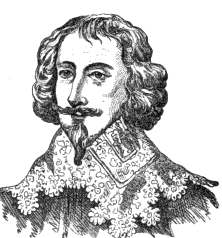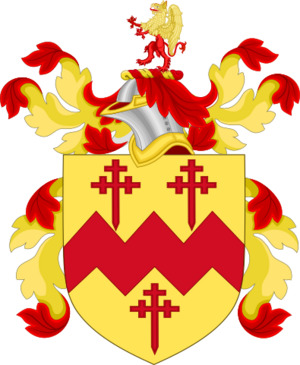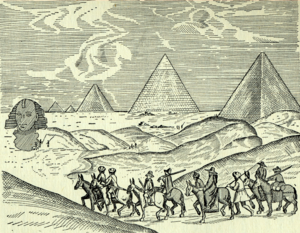George Sandys facts for kids
George Sandys (born March 2, 1578 – died March 1644) was an English explorer, writer, and poet. He traveled a lot and wrote about his adventures. He was also famous for translating important old books. His travel stories helped people learn about geography and different cultures.
Contents
The Life of George Sandys
George Sandys was born in Bishopsthorpe, England. He was the youngest of seven sons. His father, Edwin Sandys, was the Archbishop of York.
George went to St Peter's School, York and then to St Mary Hall, Oxford. In 1610, he started traveling across Europe and the Middle East. These trips led to his famous book, The Relation of a Journey begun an. Dom. 1610.
Adventures in America
Sandys was very interested in the first English settlements in America. In 1621, he became the treasurer for the London Virginia Company. This company helped set up colonies in Virginia.
He sailed to Virginia with his niece's husband, Sir Francis Wyatt. Sir Francis was the new governor there. When Virginia became a direct colony of the King, Sandys joined the council in 1624. He stayed on the council until 1628. He later returned to England for good.
Writing and Poetry
In 1621, Sandys published an English translation of part of Ovid's Metamorphoses. This was a very old and important Roman poem. He finished the full translation in 1626. This work made him famous as a poet.
He also started translating Virgil's Aeneid, another famous old poem. In 1636, he published his Paraphrase upon the Psalms. This book was his own version of the Old and New Testament psalms and hymns. His last work, a Paraphrase of the Song of Songs, came out in 1641.
George Sandys never married. He passed away in 1644 in Boxley, England. Other famous poets like Dryden and Pope praised his writing.
Travels and Travel Writing
George Sandys' travels took him to many places. He first visited France. Then he went from northern Italy through Venice to Constantinople (modern-day Istanbul). From there, he explored Egypt, Mount Sinai, Palestine, Cyprus, Sicily, Naples, and Rome.
His travel stories were collected in his book, The Relation of a Journey begun an. Dom. 1610. This book was dedicated to Charles, Prince of Wales. It became a very important source of information about the Eastern Mediterranean. People used it as a guide for many years.
Understanding Different Cultures
Sandys' travel writing was influenced by his older brother. His brother had also visited and written about the Turkish Empire. George Sandys' work helped people understand that different religions could live together peacefully. He showed this in his descriptions of the Ottoman Empire.
He was also one of the first non-Jewish travelers to say that Jewish people did not "naturally emit an unsavoury odour." This was a common, untrue belief at the time. His book was very popular. However, later writers like Lady Mary Wortley Montagu criticized his views on women.
What His Travel Books Covered
The seventh edition of The Relation of a Journey combined all four books into one. This book was printed in London in 1673. It included Sandys' travels to all the places mentioned above.
- The first book described the Turkish Empire. It talked about their laws, government, military, and trade. It also covered the Mohammedan religion (Islam) and life in Constantinople. He also wrote about Greece and its customs.
- The second book focused on Egypt. Sandys wrote about ancient Egyptian history and culture. He also described his trip on the Nile river. This book included details about Armenia, Cairo, Rhodes, and Alexandria.
- The third book was about Palestine, also known as the Holy Land. It described the Jewish and Christians living there.
- The fourth and final book covered Italy and nearby islands. These included Cyprus, Crete, Malta, Sicily, and the Aeolian Islands. Sandys also wrote about cities like Venice and Rome.
The combined book, Sandys Travels, included fifty maps and pictures.
Religious Views
George Sandys held certain religious beliefs called English Arminian views. These ideas were shown in his writings. For example, his Paraphrase upon the Psalms (1636) included comments that went against some other religious ideas of the time. He also translated a play called Christus Patiens (1639) by an Arminian religious thinker, Hugo Grotius.
Family Connections
George Sandys' brother, Edwin Sandys, was also a politician. He was an important member of the London Virginia Company, just like George. George Sandys was also the uncle of Richard Lovelace. Richard Lovelace was a famous English poet in the 1600s.
| Family tree of Edwin Sandys, Archbishop of York | |||||||||||||||||||||||||||||||||||||||||||||||||||||||||||||||||||||||||||||||||||||||||||||||||||||||||||||||||||||||||||||||||||||||||||||||||||||||||||||||||||||||||||||||||||||||||||||||||||||||||||||||||||||||||||||||||||||||||||||||||||||||||||||||||||||||||||||||||||||||||||||||||||||||||||||||||||||||||||||||||||||||||||||||||||||||||||||||||||||||||||||||||||||||||||||||||||||||||||||||||||||||||||||||||||||||||||||||||||||||||||||||||||||||||||||||||||||||||||||||||||||||||||||||||||||||||||||||||||||||||||||||||||||||||||||||||||||||||||||||||||||||||||||||||||||||||||||||||||||||||||||||||||||||||||||||||||||||||||||||||||||||||||||||||||||||||||||||||||||||||||||||||||||||||||||||||||||||||||||||||||||||||||||||||||||||||||||||||||||||||||||||||||||||||||||||||||||||||||||||||||||||||||||||||||||||||||||||||||||||||||||||||||||||||||||||||||||||||||||||||||||||||||||||||||||||||||||||||||||||||||||||||||||||||||||||||||||||||||||||||
|---|---|---|---|---|---|---|---|---|---|---|---|---|---|---|---|---|---|---|---|---|---|---|---|---|---|---|---|---|---|---|---|---|---|---|---|---|---|---|---|---|---|---|---|---|---|---|---|---|---|---|---|---|---|---|---|---|---|---|---|---|---|---|---|---|---|---|---|---|---|---|---|---|---|---|---|---|---|---|---|---|---|---|---|---|---|---|---|---|---|---|---|---|---|---|---|---|---|---|---|---|---|---|---|---|---|---|---|---|---|---|---|---|---|---|---|---|---|---|---|---|---|---|---|---|---|---|---|---|---|---|---|---|---|---|---|---|---|---|---|---|---|---|---|---|---|---|---|---|---|---|---|---|---|---|---|---|---|---|---|---|---|---|---|---|---|---|---|---|---|---|---|---|---|---|---|---|---|---|---|---|---|---|---|---|---|---|---|---|---|---|---|---|---|---|---|---|---|---|---|---|---|---|---|---|---|---|---|---|---|---|---|---|---|---|---|---|---|---|---|---|---|---|---|---|---|---|---|---|---|---|---|---|---|---|---|---|---|---|---|---|---|---|---|---|---|---|---|---|---|---|---|---|---|---|---|---|---|---|---|---|---|---|---|---|---|---|---|---|---|---|---|---|---|---|---|---|---|---|---|---|---|---|---|---|---|---|---|---|---|---|---|---|---|---|---|---|---|---|---|---|---|---|---|---|---|---|---|---|---|---|---|---|---|---|---|---|---|---|---|---|---|---|---|---|---|---|---|---|---|---|---|---|---|---|---|---|---|---|---|---|---|---|---|---|---|---|---|---|---|---|---|---|---|---|---|---|---|---|---|---|---|---|---|---|---|---|---|---|---|---|---|---|---|---|---|---|---|---|---|---|---|---|---|---|---|---|---|---|---|---|---|---|---|---|---|---|---|---|---|---|---|---|---|---|---|---|---|---|---|---|---|---|---|---|---|---|---|---|---|---|---|---|---|---|---|---|---|---|---|---|---|---|---|---|---|---|---|---|---|---|---|---|---|---|---|---|---|---|---|---|---|---|---|---|---|---|---|---|---|---|---|---|---|---|---|---|---|---|---|---|---|---|---|---|---|---|---|---|---|---|---|---|---|---|---|---|---|---|---|---|---|---|---|---|---|---|---|---|---|---|---|---|---|---|---|---|---|---|---|---|---|---|---|---|---|---|---|---|---|---|---|---|---|---|---|---|---|---|---|---|---|---|---|---|---|---|---|---|---|---|---|---|---|---|---|---|---|---|---|---|---|---|---|---|---|---|---|---|---|---|---|---|---|---|---|---|---|---|---|---|---|---|---|---|---|---|---|---|---|---|---|---|---|---|---|---|---|---|---|---|---|---|---|---|---|---|---|---|---|---|---|---|---|---|---|---|---|---|---|---|---|---|---|---|---|---|---|---|---|---|---|---|---|---|---|---|---|---|---|---|---|---|---|---|---|---|---|---|---|---|---|---|---|---|---|---|---|---|---|---|---|---|---|---|---|---|---|---|---|---|---|---|---|---|---|---|---|---|---|---|---|---|---|---|---|---|---|---|---|---|---|---|---|---|---|---|---|---|---|---|---|---|---|---|---|---|---|---|---|---|---|---|---|---|---|---|---|---|---|---|---|---|---|---|---|---|---|---|---|---|---|---|---|---|---|---|---|---|---|---|---|---|---|---|---|---|---|---|---|---|---|---|---|---|---|---|---|---|---|---|---|---|---|---|---|---|---|---|---|---|---|---|---|---|---|---|---|---|---|---|---|---|---|---|---|---|---|---|---|---|---|---|---|---|---|---|---|---|---|---|---|---|---|---|---|---|---|---|---|---|---|---|---|---|---|---|---|---|---|---|---|---|---|---|---|---|---|---|---|---|---|---|---|---|---|---|---|---|---|---|---|---|---|---|---|---|---|---|---|---|---|---|---|---|---|---|---|---|---|---|---|---|---|---|---|---|---|---|---|---|---|---|---|---|---|---|---|---|---|---|---|---|---|---|---|---|---|---|---|---|---|---|---|---|---|---|---|---|---|---|---|---|---|---|---|---|---|---|---|---|---|---|---|---|---|---|---|---|---|---|---|---|---|---|---|---|---|---|---|---|---|---|---|---|---|---|---|---|---|---|---|---|---|---|---|---|---|---|---|---|---|---|---|---|---|---|---|---|---|---|---|---|---|---|---|---|---|---|---|---|---|
Disambiguation pages: Edwin Sandys · Henry Sandys · Miles Sandys · Samuel Sandys |
|||||||||||||||||||||||||||||||||||||||||||||||||||||||||||||||||||||||||||||||||||||||||||||||||||||||||||||||||||||||||||||||||||||||||||||||||||||||||||||||||||||||||||||||||||||||||||||||||||||||||||||||||||||||||||||||||||||||||||||||||||||||||||||||||||||||||||||||||||||||||||||||||||||||||||||||||||||||||||||||||||||||||||||||||||||||||||||||||||||||||||||||||||||||||||||||||||||||||||||||||||||||||||||||||||||||||||||||||||||||||||||||||||||||||||||||||||||||||||||||||||||||||||||||||||||||||||||||||||||||||||||||||||||||||||||||||||||||||||||||||||||||||||||||||||||||||||||||||||||||||||||||||||||||||||||||||||||||||||||||||||||||||||||||||||||||||||||||||||||||||||||||||||||||||||||||||||||||||||||||||||||||||||||||||||||||||||||||||||||||||||||||||||||||||||||||||||||||||||||||||||||||||||||||||||||||||||||||||||||||||||||||||||||||||||||||||||||||||||||||||||||||||||||||||||||||||||||||||||||||||||||||||||||||||||||||||||||||||||||||||
See also
Extra sources
- This work in turn cites:
- Sandys' works as quoted above.
- Rev. Richard Hooper's edition, with memoir, of The Poetical Works of George Sandys.
- Alexander Brown's Genesis of the United States, pp. 546, 989, 992, 994–995, 1032, 1063.
- Rogers, M.A.(1974). "Books from the Library of George Sandys." The Book Collector 23 no 3 (autumn):361-370.




